Inside Stanford’s Cantor Arts Center, a newly donated collection of Jacob Lawrence’s work fills a modest exhibition space with bright colors, dynamic compositions and deeply considered artistic documentation of the African American experience. Lawrence’s paintings, drawings, prints and one illustrated book are on view for the first time together, a generous gift to the Cantor from the Kayden family.
Though the collection will remain at Stanford after the exhibition’s close as an unparallelled resource for scholars, art historians and students, Promised Land: The Art of Jacob Lawrence is a unique opportunity to linger with Lawrence’s work. His bold graphic shapes and solid blocks of color translate incredibly well in reproductions, but the small details and surprising shifts in scale that make these pieces so special easily repay an in-person viewing.
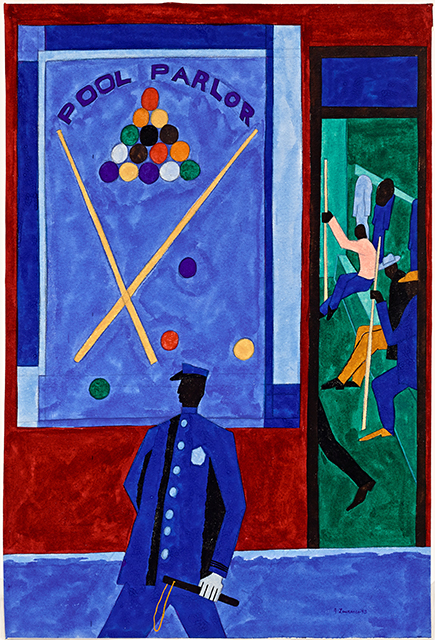
For those unfamiliar with Lawrence’s work, I’ll attempt to condense his long and illustrious artistic career. Born in 1917, Lawrence came of age in New York in the final years of the Harlem Renaissance. He attended art classes at Utopia Children’s House, studied with Charles Alston and Augusta Savage, and at age seventeen committed himself to full-time art making.
In 1941, he completed a 60-panel series The Migration of the Negro; in 1943 he joined the coast guard. His long career as an educator began in 1946 at Black Mountain College and ended in 1983 when he retired from the University of Washington, Seattle. His work ranges from the monumental (New York subway mosaics) to the intimate (delicate egg tempera on board). Until his death in 2000, Lawrence depicted historical moments and figures along with utopian visions of possible American futures, blending both into an alternative and egalitarian reality of his own making.
Promised Land is dense, both in the arrangement of artwork and in the scenes Lawrence depicted. His works on paper and board are full to the brim – the eye rarely finds a blank resting space or large swath of solid color. His paintings and drawings are filled with people in motion, at work and play. He routinely depicts scenes of labor: multiracial groups of men working in unison, tools in hand as they erect structures and shape the physical urban environment.
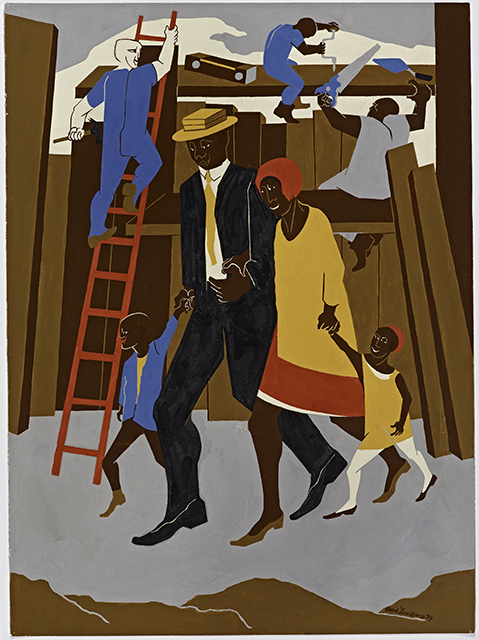
For his 1974 retrospective at the Whitney Museum of American Art, he created a gouache and tempera work on paper to serve as the poster design for the exhibition. Employing a palette of just eight colors, Lawrence depicts a family of four walking past a construction site, their legs criss-crossed, their hands entwined. As Stanford English Professor Michele Elam points out in her catalog essay, “It is important to remember that for most of the twentieth century, representing ordinary people across the color line doing ordinary things, unsegregated and unremarkable, was itself a political act.”
This optimistic depiction of the everyday is complemented by Lawrence’s dedication to documenting an underrepresented past. Repeatedly, Lawrence’s work and words affirm that the black experience is the American experience; black history is American history. Between 1937 and 1941 he focused on not just The Migration of the Negro, but the narratives of historical figures so well known today it seems surprising they could ever be ignored: Haitian revolutionary Toussaint L’Ouverture, Frederick Douglass, John Brown and Harriet Tubman.
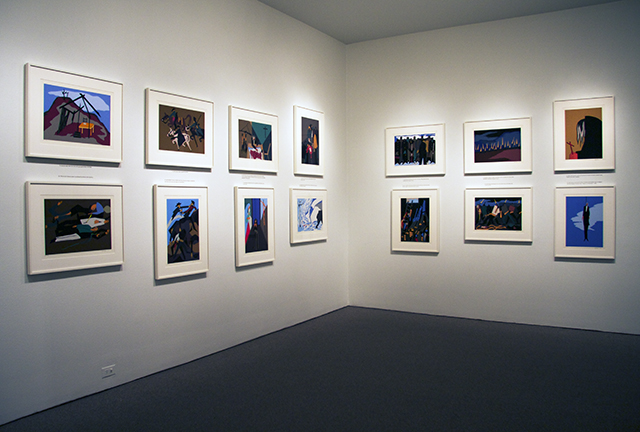
Artists Rights Society (ARS), New York)
In 1941, Lawrence painted The Legend of John Brown, reproducing the twenty-two panels as silkscreens in 1978. The entire portfolio is on view at the Cantor in two rows of framed prints. The influence of Francisco Goya, often cited in relation to Lawrence’s skill with serial formats, is evident. Lawrence’s spare use of bright colors – reserved for a trail of blood on icy blue snow and the golden points of bayonets – combine with the vignettes and descriptive text to tell the story of Brown’s doomed mission. In earthy tones, Lawrence shows Brown’s fanaticism, desperation and utter conviction, conveying a sense empathy and humanity to the scenes of Brown’s inevitable destruction.
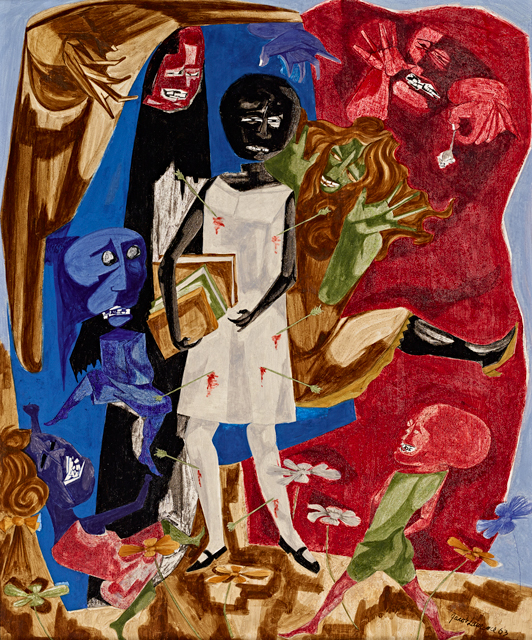
Instead of a slow build of emotion, the 1963 painting Ordeal of Alice packs everything into a 24-by-20-inch surface. Lawrence painted the work in response to the violence surrounding the integration of Southern public schools. “Alice,” clad in Mary Janes, white stockings and dress, stands clutching her books as a group of grotesque and grimacing creatures swarm around her. Arrow shafts sticking out of her body liken her to the martyred Saint Sebastian. Despite its small size, the painting promotes a visceral reaction in the viewer, a necessary reminder that Lawrence responded to not just historical prompts and dreams for the future, but the conditions of his present.
At times, it’s hard not to see connections to even our present in some of Lawrence’s pieces. The strange violence of Dreams No. 3: Toreador (1966) resembles Pablo Picasso’s Guernica, but also contains the “hands up” poses of recent protests. Do the surrounding figures offer up cheers or cries of alarm? The figure of a police officer, his baton gripped tightly, looms in the foreground of At Times It Is Hard to Get a Table in a Pool Room (1943). Alice’s ordeal is ongoing.
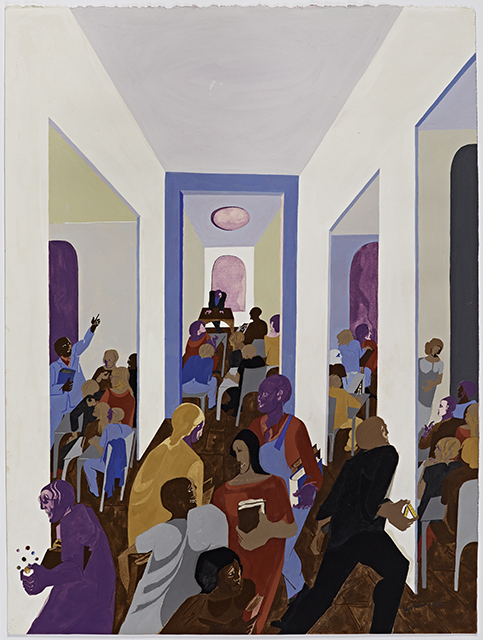
One of Lawrence’s lasting influences is his legacy as an educator; it’s fitting that the Kayden collection has found a home at the Cantor. A key piece in the exhibition, a 1977 depiction of a busy university hallway, says much about Lawrence’s educational philosophy. With a vanishing point squarely in the middle of the paper, he lays out a Giorgio de Chirico-esque interior of tall ceilings, white walls and open doorways. The action is all below the horizon line – a rare instance of broad blank space occupying one half of the composition. A student body rendered in shades of brown, pink and purple sits either in rapt attention or moves purposefully from room to room. Many hold Lawrence’s favorite tools in their hands, one is a bespectacled magician-like figure with a floating collection of spheres.
The magic of Lawrence’s work can be described similarly. As an artist with a singular style and a sense of historical conscience, he manages to hold multiple spheres of reference aloft at once – simultaneously citing art history, black experience, the drama of urban life and the satisfaction of manual labor. Lawrence’s work speaks to a broad audience without losing any of its strength and urgency, even over half a century later.

















